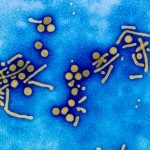Link to Pubmed [PMID] – 12475984
J. Biol. Chem. 2003 Feb;278(7):4440-8
TRBP (HIV-1 transactivating response (TAR) RNA-binding protein) and PKR, the interferon-induced dsRNA-regulated protein kinase, contain two dsRNA binding domains. They both bind to HIV-1 TAR RNAs through different sites. Binding to dsRNA activates PKR that phosphorylates the eukaryotic initiation factor eIF-2alpha leading to protein synthesis inhibition. TRBP and PKR can heterodimerize, which inhibits the kinase function of PKR and has a positive effect on HIV-1 expression. In this study, an in vitro reticulocyte assay revealed the poor expression of TAR containing CAT RNAs compared with CAT RNAs. Addition of TRBP restored translation efficiency of TAR-CAT RNA and decreased the phosphorylation status of eIF-2alpha, confirming its role as a PKR inhibitor. Unexpectedly, eIF-2alpha was phosphorylated in the presence of TAR-CAT as well as CAT RNA devoid of the TAR structure. TRBP inhibited eIF-2alpha phosphorylation in both cases, suggesting that it restores the translation of TAR-CAT RNA independently and in addition to its ability to inhibit PKR. TRBP activity on gene expression was then analyzed in a PKR-free environment using PKR-deficient murine embryo fibroblasts. In a transient reporter gene assay, TRBP stimulated the expression of a TAR-containing luciferase 3.8-fold whereas the reporter gene with mutated TAR structures or devoid of TAR was stimulated 1.5- to 2.4-fold. Overall, the activity of TRBP2 was higher when the 5′-end of the mRNA was structured and was mediated independently by each dsRBD in TRBP. Increasing concentrations of TRBP showed no significant modification of the luciferase RNA levels, suggesting that TRBP stimulates translation of TAR-containing RNAs. Therefore, TRBP is an important cellular factor for efficient translation of dsRNA containing transcripts, both by inhibiting PKR and in a PKR-independent pathway.
